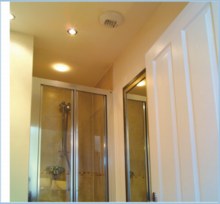Low-energy ventilation is integrated with the building structure in apartments

Discreet ventilation for two new apartment blocks near Lincoln are provided by Passivent systems that have just one fan and one external exhaust point for each flat.
Controlled ventilation with low energy consumption is provided in an apartment development in Lincolnshire with a ventilation scheme devised by Passivent and developer Redrow Homes. Lindum Point near Lincoln comprises two 3-storey apartment blocks of steel-frame construction to shorten building time. Service perforations in the steel floor joists provide a ready-made route for ventilation ducting. Mike Bury, technical director for Redrow Homes (Midlands), explains, ‘Lindum Point is our first apartment development of its type, and we needed to design a ventilation scheme that would ensure proper ventilation with minimal energy consumption. ‘We worked closely with Passivent — even to the extent of mocking up a floor plan of the apartments at Passivent’s factory — to ensure the system would function correctly. ‘The steel floor joists incorporate a service penetration, so providing a ready-made route for the ventilation ducting. The system design meant we could connect several ducts to one airbrick on the façade, minimising the number of external ventilation penetrations and maintaining the overall building aesthetics.’ The system is based on a Passivent fan-assisted ventilation scheme for each flat. A continuously running low-energy fan in each flat extracts air from ‘wet’ rooms such as kitchens, bathrooms and en-suites without causing draughts. Humidity-sensitive extracts open progressively as moisture levels increase, automatically controlling ventilation. There is only one fan in each flat and only one external exhaust point.
Related links:


